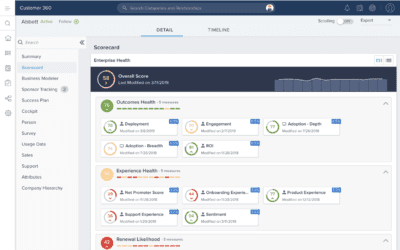At Gainsight, we value our customer’s success as our success. A key part of this strategy is to build and use customer health scores, a functionality Gainsight created in its own customer success platform for all its customers. In many B2B companies, the gross retention rate and net retention rate are the key performance indicators of the business, so most companies like to put other leading indicators or checks in place to track the customer’s health.
While scoring based on product adoption is used by many companies, that alone is not enough to get a holistic health of your customers. Adoption isn’t a sole indicator of a customer’s health, though it is an important one. A multitude of factors need to get into an accurate health score, including customer sentiment, support ticket volumes, ease of use/product experience, driving outcomes/value, correct deployment and so forth.
Tip: Low adoption is an indicator of high churn, but high churn alone is not an indicator of low adoption.
This blog will help you address the whats, whys, whens and hows of designing or redesigning your customer health score.

The When: Learning When It’s Time for a New Health Score
Chances are you might be using a metric or even a score to measure customer health. The question is, do you need a new score or do you need to revamp your existing ones?
Here are a few criteria to consider when deciding to embark on this journey.
- Product evolution: As your product evolves, the criteria by which you measure customer health will change too. For instance, at Gainsight PX, we have evolved into a fast growth mode where our product functionalities are rapidly evolving. As a result, we need to monitor a changed set of features and functionalities to measure customer health.
- Evolution of customer maturity: As customers sign up for your product, the first six months go toward getting set up, training, focusing on simpler items and so on. But as they spend more time with your product, you want to enable them with advanced goals and use cases, and this should reflect in the health tracking.
- The watermelon syndrome: When the scores are no longer signaling true customer health, it’s time for a change. One of my colleagues likes to use the watermelon syndrome analogy: Your customers start looking green from the outside but turn out to be red inside. Then you know it’s time for a change!
The Why: Identifying the Purpose and Goal of the Health Score
Now that you have decided to build customer health scores, it’s important to crystallize the purpose of the health score. This is vital for operational success. Well-defined objectives enable sound score design, executive alignment and, ultimately, buys-in from teams that will use the score.
Tip: The goal, the purpose, will define why, what and how.
In most cases, the primary purpose of the health score is to provide visibility into the health of the customers so one can accurately forecast churn and proactively assist them and mitigate attrition risk. A well-designed health score can provide a lot more value than simple visibility and forecast accuracy.
For Gainsight PX, we anchored the objective of the score around the following goals:
- Drive outcomes and value for our customers from our product.
- Grow the business by bringing in new customers as well as retaining existing ones.
The above translates into further subgoals:
- Visibility into customer health
This is a very fundamental goal to putting any health scores in place; it’s a pulse about how your customers are doing. - More impactful outcomes with advanced use cases and pain points
We are focusing on driving more impactful outcomes for our customers and aren’t only ingrained in the end user’s day-to-day way of operating but also translate into the overarching team and company goals of the business owners. The type of measures you put in place can tell you the maturity of your customers.Our PX product just started its third year, and we are focused on enabling our customers to do more with our product, processes and best practices. It’s key to reflect the advanced aspects in your health score for alignment and execution
- A more sticky product
The more advanced functions, use cases and outcomes your customers leverage, the more embedded you grow to be across their organization, which leads to frictionless renewals. - Engagement with the right owners and personas
Reflect your customers’ engagement with your organization at various levels, not only with the end users but also with the right personas who ultimately influence decision-making. - Feedback for your product team
This is a great way to provide data-driven insights to your product teams. Low adoption, a sudden drop in certain golden or sticky features, or support volumes going through the roof are indicative of product risks. It’s time for a chat with your product team.
Health Score Design: Making Choices and Tradeoffs
Make a conscious choice about taking a conservative or liberal approach. Set the expectation so you aren’t caught off guard If the majority of your customers fall in the yellow score range post-implementation. This will enable your teams to have a renewed focus on driving up the maturity of your customers’ adoption of your product. At Gainsight PX, we consciously made that choice. We would rather have more customers in the yellow and green ranges.
Tip: It’s important to note that a customer’s health is by no means a reflection of your CSM’s capability; it is only a means to understand that particular customer’s health in order to proactively help them succeed.
Designing
Customer success is a team sport, and a well-designed score reflects the interdependency of teams that own the score. For Gainsight PX, we leverage DEAR Framework for tracking outcomes health so that our score represents multiple important aspects including:
Deployment
Correct deployment with regards to configuration, setup, integrations and so forth is foundational to a customer’s success.
Engagement
Stakeholder alignment includes engagement at a day-to-day level with adoption champions but also periodic executive check-ins. Strong engagement ensures that the customer is engaged both with the product as well as the team behind it.
Adoption (Depth/Breadth)
Adoption is important because it ensures your customer is able to gain the maximum benefits from your product. Both depth and breadth are important indicators of product adoption. Just tracking the depth, such as the number of logins, time spent and so on, isn’t enough because users may be coming in and spending a lot of time simply because the product isn’t intuitive enough. Tracking usage of your high-value features is important.
ROI
ROI tracks the business impact of the product in relation to the efforts—time, cost and resources—put in by the customer. Tracking outcomes is really key. Unless customers are able to drive outcomes using our product, business owners will question the value your product is adding against the money they are investing—no matter how well customers adopt it.
Additional Inputs
We incorporate elements of experience health using the CX framework. They include NPS scores, support ticket volumes, experience surveys (onboarding, product and so on), customer sentiment and business health of the customer (e.g., if they were impacted by COVID).
The framework measures segmentation. It is not one-size-fits-all. After onboarding hundreds of customers, we determined that different segments have different goals, and it is important to reflect it in the health tracking:
- Customer lifecycle stage: The product goals for your customers differ by the stage they are in, (e.g., onboarding goals are different from their goals for the post-onboarding/adoption phase.
- Size of the customer: The goals and adoption of enterprise customers are different from those for small and medium-sized customers.
Tips for Score Design
Determine which features and functionalities make it into the health score, using a combination of quantitative and qualitative data.
- Quantitative Data: Leverage your product analytics tool (in our case, it was Gainsight PX) to determine your high-value and sticky features, assign weight by running different scenarios, get insights from support ticket data, and identify a list of workflows and functions to include.
- Qualitative Data: Get your customer-facing team’s inputs and opinions on your above hypothesis. For example, have the sales team help you understand which features help in sales and demo conversations, and get input from customer success teams about which features help the customers most and which come up during renewals.
Simplicity should be the principle. As Albert Einstein said, “Everything should be made as simple as possible, but not simpler.” While making design decisions–including how many measures to add and what to drop or include—keep simplicity in mind. Human nature is to want to include everything, so anchoring to your goal and bearing a simplistic version of doing so is key. Focus on measures that are objective, predictive and easily understood.
Implementing
During implementation, be prepared for infinite curveballs.
As measures are getting implemented, you may run into lots of blockers, a few things you may have not considered, or may decide to make some changes, so having the adaptability to adjust your plan and design to make do with some workarounds is absolutely necessary.
Testing is of immense importance during implementation. You should review the outcome of different tests and scenarios in order to make an effective decision.
Finally, have a schedule, and be on top of it. There will be a million different things that will crop up, just waiting to derail your entire project, but having the confidence to overcome them, conducting weekly and daily stand-up meetings, and incorporating some flexibility while largely sticking to your overall plan will help get you to the finish line.
Operationalizing
Once your new health score is live, the following operational workflows will ensure the scores are successfully used.
Ritualized Scores
Periodically review the scores for your whole customer base and determine the percentage of customers in the red/orange, yellow and green ranges. Make an actionable plan by determining your target KPIs, and make it part of your team’s quarterly goals. Start directionally.
Cross-Sectional Insights
One you identify these insights, spur the respective teams to act on them. For example, if your adoption depth is green, but your adoption breadth is yellow, then maybe the customers are coming to the product but aren’t using or availing your sticky and valuable features. This indicates that either some of your sticky features are hard to use or hard to find. In either case, your product team needs to do something about it.
Allocated and Prioritized Resources
The health score can help you learn where to allocate your team’s time to strategically and tactically help customers. For instance, with an initial score, we might say that if two customers are “red,” then both need additional attention, but a more nuanced and refined version of the score might map each customer to a specific attrition risk so the right prioritization, resourcing and mitigation workstreams can be deployed.
Health Score: Forecasting Customer and Product Success
Measuring customer health is a complex area with many dimensions to evaluate and consider. When done right, customer health scores offer a simple yet powerful way to measure the success of your product and your relationship with your customers and a proactive way to address issues that may arise as you scale your business.
Want to learn more about designing customer health scores? Schedule a demo of Gainsight CS today!
